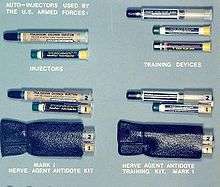Autoinjector
An autoinjector (or auto-injector) is a medical device designed to deliver a dose of a particular drug. The injectors were initially designed to overcome the hesitation associated with self-administration of the needle-based drug delivery device.

Most autoinjectors are one-use, disposable, spring-loaded syringes. By design, autoinjectors are easy to use and are intended for self-administration by patients, or administration by untrained personnel. The site of injection depends on the drug loaded, but it typically is administered into the thigh or the buttocks.
Autoinjectors are sharps waste.
Design

Designs exist for both intramuscular and subcutaneous injection. Disposable autoinjectors commonly use a pre-loaded spring as a power source. This spring and the associated mechanical components form a one-shot linear actuator. When triggered the actuator drives a three step sequence:
- accelerate the syringe forward, puncturing the injection site
- actuate the piston of the syringe, injecting the drug
- deploy a shield to cover the needle
Some injectors are triggered by simply pushing the nose ring against the injection site. In these designs the protective cap is the primary safety. Other designs use a safety mechanism similar to nail guns: The injection is triggered by pushing the nose ring against the injection site and simultaneously, while applying pressure, pushing a trigger button at the rear end of the device.
Since spent autoinjectors contain a hypodermic needle they pose a potential biohazard to waste management workers. Hence the protective cap is designed not only to protect the drug and keep the needle sterile, but also to provide adequate sharps waste confinement after disposal.
Injectors intended for application through layers of clothing may feature an adjustable injection depth. Other typical features include: A drug inspection window, color coded spent indicator and an audible click after the injection has finished.
Variants
Another design has a shape and size of a smartphone which can be put into a pocket. This design also has retractable needle and automated voice instructions to assist the users on how to correctly use the autoinjectors. The "Auvi-Q" epinephrine autoinjector uses this design.[1]
A newer variant of the autoinjector is the gas jet autoinjector, which contains a cylinder of pressurised gas and propels a fine jet of liquid through the skin without the use of a needle. This has the advantage that patients who fear needles are more accepting of using these devices. The autoinjector can be reloaded, and a variety of different doses or different drugs can be used, although the only widespread application to date has been for the administration of insulin in the treatment of diabetes.[2][3]
Examples

- Epinephrine autoinjectors are often prescribed to people who are at risk for anaphylaxis. Brand names include Anapen, EpiPen, Emerade, and Auvi-Q.
- Rebiject, Rebiject II and Rebidose autoinjectors for Rebif, the drug for interferon beta-1a used to treat multiple sclerosis. An autoinjector for the Avonex version of this same medication is also on the market.
- SureClick autoinjector is a combination product for drugs Enbrel or Aranesp to treat rheumatoid arthritis or anemia, respectively.
- Subcutaneous sumatriptan autoinjectors are used to terminate cluster headache attacks.[4]
Military use
- Autoinjectors are often used in the military to protect personnel from chemical warfare agents. In the U.S. military, atropine and 2-PAM-Cl (pralidoxime chloride) are used for first aid ("buddy aid" or "self aid") against nerve agents. An issue item, the Mark I NAAK (Nerve Agent Antidote Kit), provides these drugs in the form of two separate autoinjectors. A newer model, the ATNAA (Antidote Treatment Nerve Agent Auto-Injector), has both drugs in one syringe, allowing for the simplification of administration procedures. In the Gulf War, accidental and unnecessary use of atropine autoinjectors supplied to Israeli civilians proved to be a major medical problem.[5]
- In concert with the Mark I NAAK, diazepam (Valium) autoinjectors, known as CANA, are carried by US service members.
See also
References
- Thomas, Katie (1 February 2013). "Brothers Develop New Device to Halt Allergy Attacks". New York Times. Retrieved 6 March 2017.
- "1". Mendosa.com. 2001-01-16. Retrieved 2010-07-07.
- 2 Archived April 11, 2007, at the Wayback Machine
- May, A.; Leone, M.; Áfra, J.; Linde, M.; Sándor, P. S.; Evers, S.; Goadsby, P. J. (2006). "EFNS guidelines on the treatment of cluster headache and other trigeminal-autonomic cephalalgias". European Journal of Neurology. 13 (10): 1066–77. doi:10.1111/j.1468-1331.2006.01566.x. PMID 16987158.
- Baren, Jill M.; Rothrock, Steven G.; Brennan, John; Brown, Lance (2007-10-24). Pediatric Emergency Medicine. Elsevier Health Sciences. p. 1069. ISBN 978-1437710304.
-solution.jpg)

